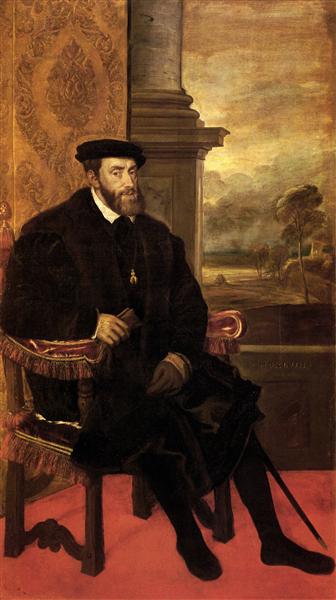Beskrivelse
The painting "Emperor Charles V Seated", painted by Titian in 1548, stands out not only for its technical quality and visual richness, but also for the depth of its subject matter, which reflects the majesty and complexity of imperial power in the European Renaissance. This portrait stands as a testament to the art of portraiture of the time, a genre where Titian became an undisputed master, capable of capturing not only the external appearance, but also the essence of the subject portrayed.
In this work, Titian presents the Emperor Charles V in an imposing pose, suggesting both authority and vulnerability. The figure of the Emperor, clad in subtle shades of colour that radiate an air of dignity, occupies the centre of the composition. His clothing, rich in textures and golden tones, is combined with a purple velvet cloak that envelops him, symbolising his status and the splendour of the monarchy. This colour choice is no coincidence; purple is traditionally a colour associated with power and royalty, and gold adds a flash of grandeur that masterfully catches the light.
The colour palette that Titian employs in this work is rich and varied, with an emphasis on warm tones that infuse the emperor with life and humanity. The play of light and shadow, a fundamental characteristic of his style, enhances the three-dimensionality of the figure, making it seem almost tangible. This luminous contrast not only defines the emperor's form, but also suggests an almost divine aura, elevating his representation to a symbolic level, reaffirming his position as the leader of a vast and complex network of territories and peoples.
Titian achieves, with consummate mastery, a balance in the composition that is both dynamic and harmonious. Looking at the emperor's posture, one perceives a slight twist in his torso, which gives him a sense of movement and a hint of introspection, as if the emperor were deep in thought about his empire and legacy. Although there are no additional characters in the painting, the strong presence of Charles V is enough to fill the space and communicate the symbolic charge of his historical figure.
An interesting aspect of this work is the context in which it was made. Charles V, emperor from 1519 until his abdication in 1556, was a central figure in the European politics of his time, and Titian was an accurate portraitist who captured the evolution of his image over the years. Their professional relationship reflected not only artistic admiration, but also a deep friendship. Titian's decision to portray the emperor in a more reflective pose, in contrast to the more military character of earlier portraits, suggests a shift in how royal power could be represented, opening the door to more nuanced interpretations of authority in art.
In short, “Emperor Charles V Seated” is a work that transcends mere portraiture, imbuing its depiction with a series of complex meanings and a dialogue between subject and viewer. Titian’s technical mastery in the use of color, light, and form, combined with the portrait’s emotional depth, make it a landmark of the Renaissance. This work not only documents the presence of a sovereign, but also invites contemplation on the ephemeral nature of power and the legacy it leaves behind, offering, with each glance, a new perspective on one of the most influential monarchs in history.
KUADROS ©, a famous painting on your wall.
Hand-made oil painting reproductions, with the quality of professional artists and the distinctive seal of KUADROS ©.
Painting reproduction service with satisfaction guarantee. If you are not completely satisfied with the replica of your painting, we will refund 100% of your money.

